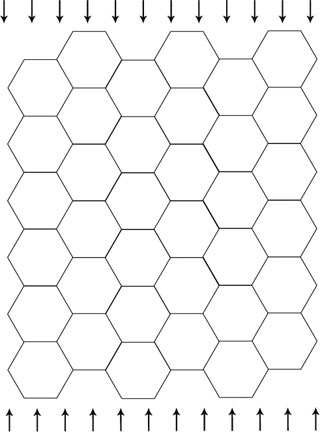16.2: Compression of a Honeycomb: Experimental
- Page ID
- 7886
The honeycomb studied here is an array of regular hexagonal cells, with the cell walls made of thin strips of aluminium. The structure is not quite as simple as it first appears because of the way in which it is made (see details). This causes one in every three cell walls to consist of two layers of aluminium bonded with adhesive, making some walls stiffer than others. In the honeycomb used here the thickness of an individual sheet, t, was 0.09 mm, and the length of each of the cell faces, l, was 6.30 mm. The relative density, the measured density as a fraction of the density of the solid material, is 0.008.
There are two different directions in which a hexagonal honeycomb can be compressed in the plane of the honeycomb.
 |
 |
| Cell walls lie parallel to the loading axis | Cell walls lie diagonal to the loading axis |
Although quantitatively different, the basic deformation processes are similar in both cases so only the situation where some cell walls lie parallel to the loading axis is described here.
Squares of honeycomb with 6 cells along each side were cut from a sheet of material. The samples were then compressed between flat, parallel platens at a constant displacement rate of 1 mm min-1, giving the stress-strain curve below.
The stress-strain curve has 3 distinct regions:
- an initial elastic region;
- followed by the onset of irreversible leading to region where the stress does not change with increasing strain, known as the plateau region;
- and lastly a region where the stress again begins to rise rapidly with increasing strain, known as densification.
Elastic region
The elastic region is characterised by the effective Young modulus of the material, that is the Young modulus of a uniform material that for the same imposed stresses gives rise to the same strains. This is found by taking the slope of the unloading curve, which helps to reduce the effects of any local plastic flow.
The measured Young modulus was 435 kPa.
Plateau region
With continued loading the stresses in the faces increase. Eventually these reach the flow stress of the material and irreversible yielding begins. The stress at which this occurred was approximately 15 kPa. The structure then began to collapse at an approximately constant stress, σP.
Densification
This continued up to a strain of ~ 0.7, at which point the stress started to rise much more rapidly as the faces from opposite sides of the cells were pressed up against one another.
This three-stage deformation behaviour is typical of virtually all highly porous materials, even ones made of very brittle materials. The next step is to try and quantitatively describe the observed behaviour.


